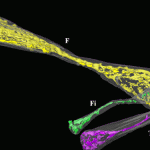
Image: The structure of plasminogen has been mapped for the first time (pictured). Credit: James Whisstock via Wikimedia Commons
Plasminogen’s unstable behaviour is the key to plasmin generation.
Researchers from Monash University and the Australia Synchrotron have discovered how a blood clot-busting enzyme, plasmin, is converted from plasminogen for the first time. This discovery, published in Cell Reports, could lead to new treatments for clotting and bleeding disorders as well as some cancers.
Scientists have been trying to understand this process for nearly a century, according to author Professor James Whisstock from Monash University. “Plasminogen is quite unstable and readily adopts different conformations… In addition there are lots of different types (or glycoforms) of plasminogen in humans. These different glycoforms have different properties and stabilities. We needed to address these issues to obtain crystals,” says Whisstock.
To map the atomic structure, the researchers used the intense X-ray crystallography beamline at the Australian Synchrotron. “Plasminogen only yielded its secrets when exposed to the most focused and powerful X-rays the Synchrotron can currently produce — technology which has only become available in the past few years,” says Dr Tom Caradoc-Davies, from the Australian Synchrotron.
A close look at the structure revealed that while plasminogen appeared to guard its activation site, part of it seemed unstable and temporarily exposed a key site. The proteins in the blood clots were then able to bind to the molecules, trapping it in a form that can be converted to plasmin.
Heart attack and stroke patients are currently treated with plasminogen activators, which activate plasminogen to generate plasmin. “Without the structure of plasminogen, it is difficult to understand how these drugs work and how to develop better approaches to activating plasminogen in the context of clotting disease,” Whisstock says.
Plasmin inhibitors are also being developed as anti-cancer therapeutics, as it is responsible for breaking down tissue barriers in cancer.
““Laura Boness
Source: Monash University






